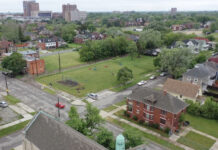As I was reading a fascinating article in The Atlantic penned by Andrew McGill, I couldn’t help but think back to when my parents moved our family from a big, two-story frame home on the east side of Detroit to a tidy, new, three-bedroom ranch just outside the village limits of Milan (pop. 1500) in north-central Ohio.
My dad and mom made the move for two reasons — 1. my parents, committed UAW members, both found new jobs in the auto manufacturing industry in nearby communities, and 2. Detroit was beginning to show signs of economic stress and the multicultural, industrial neighborhood we lived since the late 1940s was changing too fast for my parents.
Our new home, clad in aluminum siding and with a single large picture window announcing its living room, was one of about 30 identical homes rapidly constructed on a former goat farm. Some buyers opted for white houses and others choose pastels of green, blue, yellow and — in our case and several others — pink houses. (I was the only kid in our high school living in a pink house.)
One of the first things almost every homebuyer did was to plant grass in their half-acre of sandy soil. Everyone wanted a lawn and they wanted it fast. A few residents even planted trees, shrubs and flowers. My mother (she died under my sister’s care on Christmas eve four years ago) planted a single row of snapdragons down one side of the asphalt driveway leading up to our two-car garage. After getting home from her shift in the nearby auto parts plant, she would water and admire her snapdragons, that like the tiny houses in our young neighborhood, blossomed in a variety of pastels.
What do these long-ago memories this have to do with The Atlantic article I mentioned previously? A lot really.
Our small development, carved out of farmland and treeless to begin with, was probably like thousands of others built in the 1950s and 1960s — clusters of hastily constructed small ranch houses surrounded by large (at least in proportion to the size of the homes) bare lots. Today, Americans are opting for much bigger houses built on small lots.
McGill, in his compelling article, “The Shrinking of the American Lawn,” shares statistics gathered from several reliable sources about the relationship between home sizes and lawns. What he shares should give us, as professional lawn service providers, pause.
Writes McGill in The Atlantic: “As homes have grown larger, the lots they’re built on have actually gotten smaller — average area is down 13 percent since 1978, to 0.19 acres. That might not seem like a lot, but after adjusting for houses’ bigger footprints, it appears the median yard has shrunk by more than 26 percent, and now stands at just 0.14 acres.”
He concludes by writing that forced to choose between having a bigger lawn and a bigger house, Americans who live near economic hubs are picking the house.
The boxy, smallish ranch house of the ’50s, ’60s and ’70s, with its big picture window looking over an expanse of lawn, is an anachronism. Someday, the houses being built today (including the McMansions of the 1980s and 1990s) will be viewed similarly. As American’s home-buying preferences change, so too will the landscape and lawn services they desire.
What changes do you anticipate for the services your business offers? Share with us in the comments.











![[VIDEO] Dickies®: Discover Workwear That’s Anything But Uniform](https://turfmagazine.com/wp-content/uploads/2023/06/1647663814-4b1a2a7742790a9b1e97a3b963477850192e1d6a9dfba9b07214a77bae25d6e3-d-218x150.jpg)




























![[VIDEO] Dickies®: Discover Workwear That’s Anything But Uniform](https://turfmagazine.com/wp-content/uploads/2023/06/1647663814-4b1a2a7742790a9b1e97a3b963477850192e1d6a9dfba9b07214a77bae25d6e3-d-324x160.jpg)